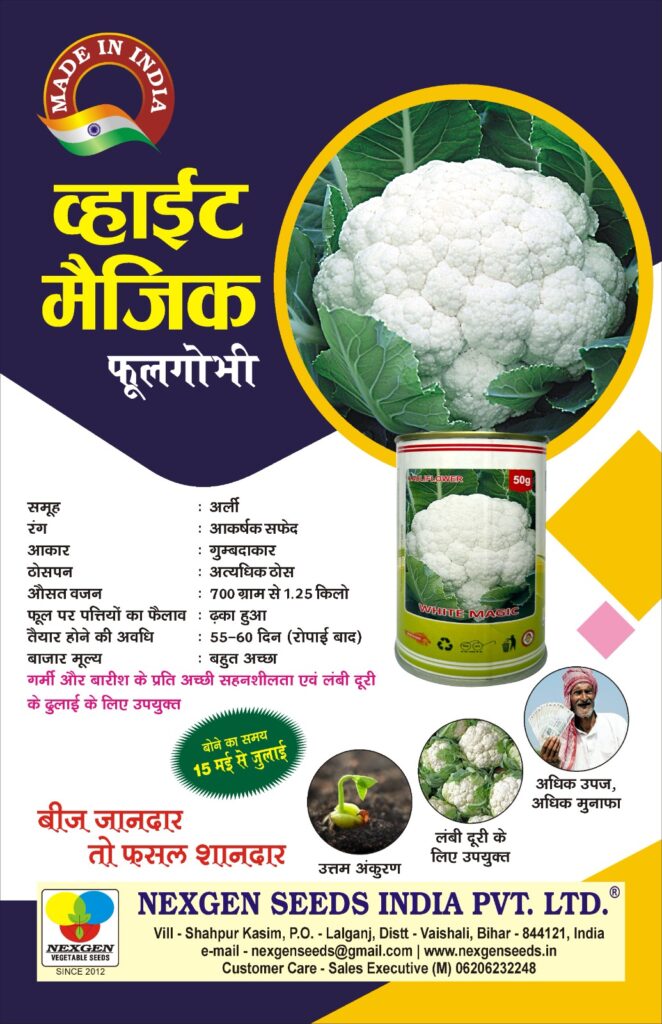Introduction:
Welcome to our step-by-step guide on how to grow cauliflower from seeds in just 65 days! Cultivating your own cauliflower at home is not only a rewarding experience, but it also ensures you have access to fresh, pesticide-free produce. As a cool-season crop, cauliflower is perfect for planting during early spring or fall. With the right care and attention, you can enjoy a bountiful harvest in just over two months. Let’s dive into the process!

Step 1: Choose Your Cauliflower Seeds
To start, you’ll need to select the right cauliflower seeds for your garden. There are many varieties to choose from, each with their own unique flavor, color, and growth rate. Some popular options include:
– Snowball: A classic white cauliflower with a compact head, maturing in 65 days.
– Cheddar: A vibrant orange variety, high in beta-carotene, and ready for harvest in 68 days.
– Graffiti: A stunning purple cauliflower, rich in antioxidants, and matures in 75 days.
Step 2: Sow the Seeds Indoors
Begin by sowing your chosen cauliflower seeds indoors, approximately 6-8 weeks before the last expected spring frost. This will give your seedlings a head start and ensure they are strong enough to transplant outdoors.
1. Fill seed trays or small pots with seed compost, leaving a ¼ inch gap at the top.
2. Place 2-3 seeds per cell, covering them with a thin layer of compost.
3. Water the seeds gently, ensuring the compost is moist but not waterlogged.
4. Place the trays in a warm, well-lit area, maintaining a temperature of 65-70°F.
5. Keep the compost moist, and you should see seedlings emerge within 5-10 days.
Step 3: Harden Off Seedlings
Once your seedlings have developed 2-4 true leaves, it’s time to harden them off. This process acclimates the young plants to outdoor conditions, reducing transplant shock.
1. Begin by moving the seedlings outdoors to a sheltered spot for a few hours each day.
2. Gradually increase their exposure to sunlight and cooler temperatures over a week.
3. Ensure your seedlings are protected from strong winds and direct sunlight during this period.
Step 4: Transplant Seedlings Outdoors
When your cauliflower seedlings are ready to face the great outdoors, it’s time to transplant them into your garden.
1. Choose a sunny spot with well-draining soil, enriched with compost or well-rotted manure.
2. Space the seedlings 18-24 inches apart, with rows approximately 30 inches apart.
3. Gently remove the seedlings from their trays, taking care not to damage the roots.
4. Plant them at the same depth they were in the trays, firming the soil around them.
5. Water the seedlings thoroughly, adding a layer of mulch to conserve moisture and suppress weeds.
Step 5: Care and Maintenance
To ensure your cauliflower plants thrive, follow these simple care and maintenance tips:
1. Water your plants regularly, keeping the soil consistently moist but not waterlogged.
2. Apply a balanced liquid fertilizer every 2-3 weeks to provide essential nutrients for growth.
3. Keep an eye out for pests such as cabbage worms, aphids, and slugs. Use organic pest control methods, like introducing beneficial insects or using diatomaceous earth.
4. Regularly check for diseases such as clubroot, black rot, and downy mildew. Remove any infected plants and practice crop rotation to prevent the spread of diseases.
5. As the cauliflower heads begin to form, consider blanching them to maintain their color and flavor. Gently fold the outer leaves over the developing head and secure them with a rubber band or soft twine. This protects the head from direct sunlight and keeps it tender.
Step 6: Harvest Your Cauliflower
After approximately 65 days (depending on the variety), your cauliflower should be ready to harvest.
1. Look for firm, compact heads that have reached their mature size, usually 6-12 inches in diameter.
2. Use a sharp knife to cut the stem about an inch below the head, leaving a few leaves attached to protect it during storage.
3. Enjoy your fresh, homegrown cauliflower in a variety of dishes, or store it in the refrigerator for up to two weeks.
Conclusion:
Growing cauliflower from seeds in just 65 days is an achievable goal with the right care and attention. By following this comprehensive guide, you’ll enjoy a bountiful harvest of fresh, homegrown cauliflower. Not only will you save money and reduce your ecological footprint, but you’ll also reap the health benefits of this nutrient-packed vegetable. Happy gardening!
Bonus Tips for Growing Cauliflower Successfully:
Here are some additional tips to help you grow cauliflower successfully and maximize your harvest:
1. Companion planting: Planting cauliflower alongside beneficial companion plants can help deter pests, improve soil health, and boost your overall harvest. Some good companions for cauliflower include onions, garlic, beets, celery, and chamomile.
2. Succession planting: To enjoy a continuous supply of cauliflower throughout the growing season, use succession planting. Start a new batch of seeds every few weeks, so you always have seedlings ready to replace harvested plants.
3. Optimize growing conditions: Cauliflower thrives in cool temperatures, with an ideal range of 60-70°F. If you live in a warmer climate, consider planting heat-tolerant varieties or using shade cloth to protect your plants from the afternoon sun.
4. Monitor soil pH: Cauliflower plants prefer slightly acidic to neutral soil, with a pH of 6.0 to 7.0. Test your soil and adjust its pH, if necessary, using lime (to raise pH) or sulfur (to lower pH).
5. Prevent soil compaction: Compacted soil can stunt the growth of cauliflower plants and reduce your harvest. To avoid this issue, avoid walking on the planting beds and use a garden fork to gently loosen the soil around your plants.
Incorporating these bonus tips into your cauliflower-growing routine will further increase your chances of a successful harvest. The more care and attention you give to your plants, the more likely they are to reward you with a bountiful supply of delicious cauliflower. Remember that every growing season is different, so don’t be discouraged if you face challenges along the way. With experience and perseverance, you’ll become a cauliflower-growing expert in no time!

Extending Your Cauliflower Culinary Experience:
Now that you’ve mastered growing cauliflower, it’s time to explore various ways to enjoy this versatile vegetable in your culinary adventures. Cauliflower is not only rich in nutrients like vitamin C, vitamin K, and fiber, but it’s also low in calories and can be used as a substitute for higher-carb ingredients. Here are some ideas to spark your creativity in the kitchen:
1. Cauliflower rice: Grate or process cauliflower florets into rice-sized pieces and then sauté them with your favorite seasonings. Cauliflower rice can be used as a low-carb alternative to regular rice in various dishes.
2. Cauliflower mash: Boil or steam cauliflower florets until tender, and then mash them with butter, cream, and your favorite seasonings. This dish is a great low-carb alternative to mashed potatoes.
3. Cauliflower pizza crust: Combine cauliflower rice, egg, and cheese to make a delicious pizza crust that’s perfect for a gluten-free or low-carb diet.
4. Roasted cauliflower: Toss cauliflower florets with olive oil, salt, and pepper, and then roast them in the oven until they’re caramelized and tender. You can also experiment with different seasonings and herbs to suit your taste preferences.
5. Cauliflower steaks: Slice cauliflower heads into thick “steaks” and grill or pan-sear them for a delicious, meat-free main course.
6. Pickled cauliflower: Preserve your cauliflower harvest by making pickles. Combine vinegar, water, sugar, and spices, and then pour the mixture over your cauliflower florets. Allow them to marinate in the refrigerator for a tangy, crunchy snack.
With endless ways to enjoy your homegrown cauliflower, you’ll never grow tired of this nutritious and versatile vegetable. By incorporating cauliflower into your diet, you’ll be able to enjoy the fruits of your labor while maintaining a healthy, balanced lifestyle. Happy cooking!
Cauliflower Nutrition and Health Benefits:
As you continue to enjoy your homegrown cauliflower in various dishes, it’s essential to understand the nutritional benefits this cruciferous vegetable offers. Here are some key health benefits of cauliflower:
1. Rich in antioxidants: Cauliflower is high in antioxidants like vitamin C and various phytonutrients, which help protect your cells from damage caused by free radicals.
2. Anti-inflammatory properties: Cauliflower contains compounds like sulforaphane and indole-3-carbinol, which have been shown to have anti-inflammatory effects and may help reduce the risk of chronic diseases.
3. Supports digestion: With a high fiber content, cauliflower aids in digestion, promotes regular bowel movements, and supports a healthy gut microbiome.
4. Boosts brain health: The choline in cauliflower is essential for maintaining the structure of cell membranes and supporting brain health, including memory and cognitive function.
5. Aids in weight management: Low in calories and high in fiber, cauliflower can help you feel full, making it easier to control portion sizes and manage your weight.
6. Supports heart health: The antioxidant and anti-inflammatory properties of cauliflower, combined with its fiber content, may contribute to improved heart health by reducing blood pressure and cholesterol levels.
Cauliflower is a nutrient-dense and versatile vegetable that can be enjoyed in a variety of dishes, making it an excellent addition to any meal plan. By incorporating this cruciferous vegetable into your diet, you’ll not only enjoy its delicious flavors but also reap its numerous health benefits.
In conclusion, growing your own cauliflower from seeds in just 65 days is a rewarding and health-promoting endeavor. By following the steps outlined in this guide and experimenting with various recipes, you’ll be well on your way to enjoying a bountiful harvest and a healthier lifestyle. Keep growing, harvesting, and cooking your way to a well-rounded, nutritious diet with homegrown cauliflower!
1. Lack of germination: Insufficient soil moisture and temperature can cause low seed germination rates. Solution: Ensure the soil is moist and the temperature is between 60-70°F (15-21°C) for optimal germination.
2. Poor seed quality: Low-quality seeds result in stunted growth and lower yields. Solution: Purchase high-quality cauliflower seeds from a reputable supplier.
3. Inadequate soil preparation: Poor soil preparation can lead to nutrient deficiency, compacted soil, and poor drainage. Solution: Prepare the soil by adding organic matter, such as compost, and ensure the soil is well-draining.
4. Pests and diseases: Insects and diseases can damage or kill cauliflower plants. Solution: Use organic pest control methods, such as companion planting and neem oil, and practice crop rotation to prevent disease buildup.
5. Lack of sunlight: Cauliflower plants require at least 6 hours of sunlight per day. Solution: Choose a growing location with plenty of sun exposure or use grow lights if growing indoors.
6. Overcrowding: Overcrowding can lead to stunted growth and increased competition for nutrients. Solution: Thin seedlings to maintain a distance of 18-24 inches (46-61 cm) between plants.
7. Improper watering: Over- or under-watering can lead to poor growth and reduced yields. Solution: Water consistently, providing 1-2 inches (2.5-5 cm) of water per week, and ensure the soil is well-draining.
8. Nutrient deficiencies: Lack of essential nutrients can lead to stunted growth and poor yields. Solution: Use a balanced fertilizer or compost to provide necessary nutrients.
9. pH imbalance: Soil pH that is too high or too low can affect nutrient availability. Solution: Test soil pH and adjust as needed using lime or sulfur.
10. Lack of air circulation: Poor air circulation can lead to fungal diseases and stunted growth. Solution: Provide adequate spacing between plants and use fans if growing indoors.
11. Inconsistent temperature: Fluctuating temperatures can stress plants and reduce yields. Solution: Maintain a consistent temperature range of 60-70°F (15-21°C) throughout the growing period.
12. Lack of pollination: Poor pollination can lead to poor yields. Solution: Attract pollinators such as bees by planting flowers nearby, or consider hand-pollinating the flowers.
13. Weeds: Weeds can compete with cauliflower plants for nutrients and water. Solution: Use mulch or hand-weed regularly to keep the area around plants weed-free.
14. Inadequate support: Heavy cauliflower heads can cause the plant to bend or break. Solution: Provide support for the plant using stakes or cages.
15. Lack of planning: Poor planning can lead to planting at the wrong time, or not allowing enough time for growth. Solution: Plan ahead and consider the ideal planting date for your location, as well as the 65-day growth period.
16. Inadequate ventilation: Poor ventilation can lead to the buildup of moisture and humidity, which can cause fungal diseases. Solution: Provide adequate ventilation, especially if growing in a greenhouse or indoor environment.
17. Poor harvesting techniques: Improper harvesting techniques can damage the plant or reduce yield. Solution : Harvest cauliflower heads when they are firm and compact, typically when they are 6-8 inches (15-20 cm) in diameter. Cut the head just above the lowest set of leaves, using a sharp knife.
18. Lack of crop rotation: Planting cauliflower in the same location year after year can lead to disease buildup and nutrient depletion. Solution: Practice crop rotation, alternating cauliflower with other crops to maintain soil health.
19. Lack of pest monitoring: Failure to monitor for pests can lead to infestations that can quickly damage or kill plants. Solution: Regularly inspect plants for signs of pests and take prompt action if detected.
20. Poor record-keeping: Failure to keep track of planting dates, fertilization schedules, and other important details can make it difficult to optimize future growing seasons. Solution: Keep detailed records of planting dates, fertilization schedules, pest management strategies, and other important details to improve future growing seasons.
By addressing these 20 common pain points faced by farmers when growing cauliflower from seeds in 65 days, it is possible to optimize growth and maximize yields. By implementing these solutions, farmers can help ensure a successful harvest and improve overall crop health.
Top 25 frequently asked questions and answers on how to grow cauliflower from seeds in 65 days
top 25 frequently asked questions and answers on how to grow cauliflower from seeds in 65 days
1. How long does it take to grow cauliflower from seeds?
– It takes approximately 65 days to grow cauliflower from seeds.
2. When should I start cauliflower seeds?
– You should start cauliflower seeds indoors 6-8 weeks before the last frost date in your area.
3. What is the best time to plant cauliflower seeds?
– The best time to plant cauliflower seeds is during the cool season, either in early spring or late summer.
4. How deep should I plant cauliflower seeds?
– You should plant cauliflower seeds about ¼ inch deep in the soil.
5. How much space do cauliflower plants need?
– Cauliflower plants need about 18-24 inches of space between each plant.
6. What type of soil is best for growing cauliflower?
– Cauliflower grows best in well-draining soil that is rich in organic matter.
7. How often should I water my cauliflower plants?
– Cauliflower plants should be watered deeply about once a week, or more frequently in hot, dry weather.
8. How much sunlight do cauliflower plants need?
– Cauliflower plants need full sun for at least 6 hours a day.
9. How do I protect my cauliflower plants from pests and diseases?
– You can protect your cauliflower plants from pests and diseases by using row covers, practicing crop rotation, and using organic pesticides.
10. How do I fertilize my cauliflower plants?
– You can fertilize your cauliflower plants with a balanced organic fertilizer once a month.
11. When should I harvest my cauliflower?
– You should harvest your cauliflower when the head is firm and compact, and before it starts to turn yellow.
12. How do I harvest cauliflower?
– To harvest cauliflower, cut the head off the plant with a sharp knife, leaving a few leaves attached to the stem.
13. Can I grow cauliflower in containers?
– Yes, you can grow cauliflower in containers as long as the container is at least 12 inches deep and wide.
14. How many cauliflower plants should I grow?
– You can grow as many cauliflower plants as you want, but keep in mind that each plant requires about 18-24 inches of space.
15. Can I grow cauliflower in hot climates?
– Cauliflower prefers cool weather, but you can still grow it in hot climates by planting it in partial shade and providing plenty of water.
16. How do I know when to water my cauliflower plants?
– You should water your cauliflower plants when the top inch of soil feels dry to the touch.
17. Can I grow cauliflower in sandy soil?
– Yes, you can grow cauliflower in sandy soil as long as you amend the soil with organic matter to improve its water retention.
18. Can I grow cauliflower in acidic soil?
– Yes, you can grow cauliflower in acidic soil as long as the soil pH is between 6.0 and 7.0.
Maximizing Yield with Cauliflower Seeds in India


